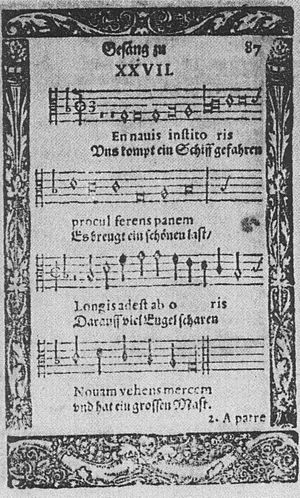Es kommt ein Schiff, geladen facts for kids
Quick facts for kids "Es kommt ein Schiff, geladen" |
|
|---|---|
| Advent song | |

"Uns kompt ein Schiff gefahren", Andernacher Gesangbuch, Cologne 1608, oldest evidence of the song
|
|
| Written | before 1450 |
| Text | Johannes Tauler? |
| Language | German |
| Published | 1608 |
"Es kommt ein Schiff, geladen" ("A ship is coming, laden"), is an Advent season chorale and Marian Hymn. It is one of the oldest religious songs of German origin.
Contents
History
The oldest existing text source is a manuscript dated before 1450. It was found in the Strasbourg Dominican convent of St. Nikolaus in undis. Due to the fact that the mystic Johannes Tauler visited this convent frequently, the lyrics of this song are attributed to him. Reference is the word "enphohet" (received) which is characteristically used by Tauler very often.
The lyrics are typical for the allegory in the Middle Ages as a vital element in the synthesis of biblical and classical traditions. Biblical motifs compare the pregnant Virgin Mary with a loaded entering ship. The ship is set in motion under sail (correspondent to love) and mast (correspondent to the Holy Spirit).
The oldest source of the melody is included in Andernacher Hymns (1608). The song is found there in bilingual text under the title "Vns kompt ein Schiff gefahren" as well as the Latin "En nauis institoris".
Lyrics
|
Es kommt ein Schiff, geladen |
There comes a galley, laden |
Melody
<score sound raw> \header { tagline = ##f } \layout { indent = 0\cm \set Score.tempoHideNote = ##t \context { \Score \remove "Bar_number_engraver" } \context { \Voice \remove "Dynamic_engraver" } }
global = { \key d \minor \time 6/4 \partial 4 }
soprano = \relative c { \global a4^\mf | a2 a4 c2 c4 | d2. d2 a4 | bes2 bes4 g2 g4 \time 4/4 | a2 r4^\ff \tempo 4=108 f4^\markup { \italic "c.f." } | a c d d | c8 (bes a g) f4 g | a g f e | d2. \bar "|." }
alto = \relative c' { \global d4_\mf | d2 d4 g2 g4 | a2 (g4) f2 e4 | d2 d4 d2 c4 \time 4/4 | c2 r4 c4 | f f f f | c2 d4 e | f c d c | d2. \bar "|." }
tenor = \relative c { \global d4_\ff^\markup { \italic "c.f." } | d2 d4 e2 e4 | f (g a) a2 a4 | g2 g4 d2 e4 \time 4/4 | f2 r4 a_\mf | c c bes bes | a2 a4 c c c a a | <a fis>2._\pp \bar "|." }
bass = \relative c { \global d4_\mf | d2 d4 d2 d4 | d2. d2 c4 | bes2 bes4 bes2 c4 \time 4/4 | f2 r4 f4 | f e d bes | f'4. (e8) d4 c | f e d a' | d2. \bar "|." }
verse = \lyricmode { Es kommt ein Schiff, ge -- la -- den bis an sein höch -- sten Bord, trägt Got -- tes Sohn voll Gna -- den, des Va -- ters e -- wigs Wort. }
\score { \new ChoirStaff << \new Staff \with { midiInstrument = "trumpet" \consists "Merge_rests_engraver" } << \new Voice = "soprano" { \voiceOne \soprano } \new Voice = "alto" { \voiceTwo \alto } >> \new Lyrics \lyricsto "soprano" \verse \new Staff \with { midiInstrument = "trombone" \consists "Merge_rests_engraver" } << \clef bass \new Voice = "tenor" { \voiceOne \tenor } \new Voice = "bass" { \voiceTwo \bass } >> >> \layout { } \midi { \tempo 4=120 } } </score>
- c.f. = cantus firmus
Musical setting
Max Reger quotes the tune in his organ pieces Sieben Stücke, Op. 145.


